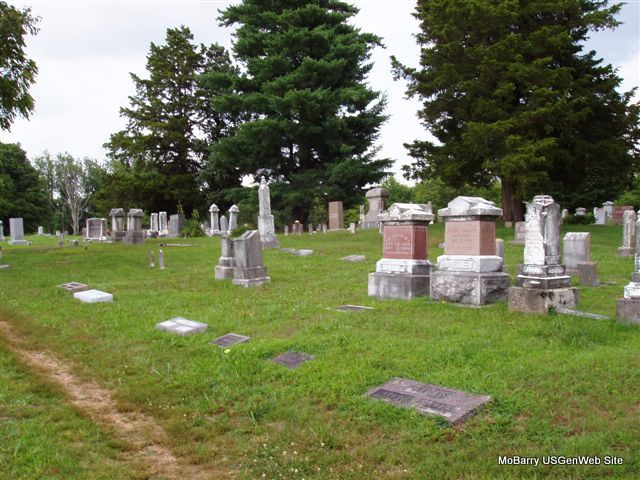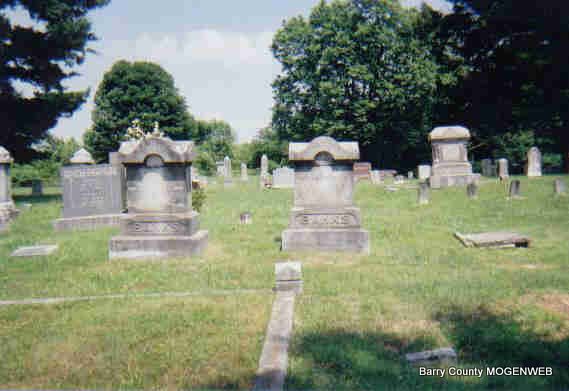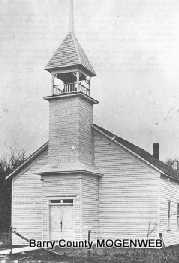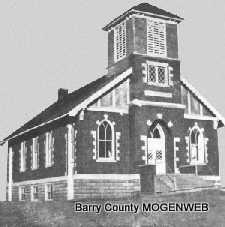New Site Cemetery
AKA Walnut Grove Cemetery
Barry Co., MO
West of Monett, Barry Co., MO
Monett Twp.
Land Office Location - NW Sec. 11, T25N, R28W
GPS - 363134N 0935814W
Monett Twp.
Land Office Location - NW Sec. 11, T25N, R28W
GPS - 363134N 0935814W




New Site Church 1876-1916 New Site Church 1916
The New Site Church is located at the intersection of 1060 and 2020 in T25N R28W S2. The cemetery is a little over a mile southwest of the church in S11. The New Site Church was built in its current location on the Banks farm in 1916. Prior to that time and going back to its founding about 1848, it had several locations. According to a church history, from about 1872 to 1878, it met in the Walnut Grove School, which was located at the corner where the cemetery lane turns off from FR 1050. It is assumed that the cemetery was started in that time period, which accounts for its location away from the current church. History submitted by Bob Banks
Directions: From the junction of highways 60 & 37 in Monett, go approximately 2.5 miles west on highway 60, then 1.4 miles south on FR 1050.
Darla Marbut and Donna Cooper canvassed this cemetery and transcribed all the stones that were readable in 2003 and submitted photos.
The New Site Story
An article from Monett Times - a long time ago - reads like this:
Visit to Old Cemetery On Spring Day Provides Lesson In Area History:
"Perhaps no experience can bring the past closer and create a more profound awareness of one's heritage than a visit to an old cemetery with its moss covered stones beneath which lie those who struggled with bring in civilization to a virgin land. The experience can be especially pleasant when the day is a balmy spring one and when the guide is Rev. Oscar Higgins (Higgins married into the Haddock family) who is a living book on the history of this area.
The burial ground is the New Site Cemetery, one of the oldest in the country, located on a windswept hilltop south and west of Monett, MO, and well tended despite its age with tall pines and other trees witnessing to the loving care it has received through the years. In the foreground of the cemetery in quiet area are two matching tombstones which speak of a time when rearing children was much more hazardous than it is today with modern medicines reducing the threat of childhood diseases.
Beneath the stones lie two sons of William and Mahala Montgomery, grandparents of Rev. Higgins, who were among the earliest setters of the New Site area, homesteading a large acreage which included the present burial ground. One of the graves is that of Monroe Montgomery, who was born in 1841 and who died on Sep 16, 1851, at the age of ten. With no public cemeteries at that time, one can imagine the distraught parents as they selected a beautiful spot on the homestead as a final resting-place for this child.
It was several years before the second grave was dug, and in the meantime, the family had returned to Illinois from whence they had come, driven by the horrors in this area in the pre-Civil War era. While in Illinois, William Montgomery died and was buried there, but when the war moved on from Missouri, perhaps drawn by the child's grave, the mother and the remainder of the family returned to the homestead. Shortly after in 1864, the second son, Jasper died at the age of 16, and his grave was placed beside that of his brother.
At the time the Montgomerys first registered their homestead in the early 1800's this entire part of the country was a wilderness, with timber and grass unbroken by roads as far as the eye could see. The nearest town was Granby and though it was merely a mining settlement, it was there that the family went by horseback for supplies, starting the trip in early morning. In later years, the original home, just over the rise from the grave and overlooking a wide valley down to the creek, was used as a resting place for those settlers from farther south on their way to Pierce City by team and wagon to buy supplies. It was also used for the collection of taxes of the county.
During this period, too, the cemetery became a popular burying ground with caskets brought by wagon from all over the county. The Montgomery family plot also filled through the years with all of the children buried there in addition to the mother of William Montgomery, Rev. Higgins' great-grandmother, Mrs. Eleanor (Carson) Montgomery, who was born in Ireland in 1783 and who died in 1864. Her grave is beneath a large pine tree. In the family plot, the death of the mother, Mahala (Segrest), is marked by a stone dated Sep 1887 (it reads, Mahala wife of W. Montgomery born Sep 6, 1822 d. Apr 9, 1887).
At that time, the homestead was divided among the family, and the two-acre burial ground, on the property of Joel Montgomery, uncle of Rev. Higgins, was deeded to the New Site Church with the stipulation that no grave plots were ever to be sold. The church, according to Rev. Higgins has followed this ruling to the letter. And he now serves as cemetery sexton. The history of the church has closely paralleled that of the early settlers, having been organized in 1848.
The first services were held in a log school building a mile north of Pulaskifield, and the second building was a mile east of Pulaskifield. Later the church was built near the present Clifford Gray farm where it remained until 1916 when the sanctuary now used was built. Rev. Higgins recalls his own youth in the area. Born in 1884 on the old homestead, he can remember the wagons and teams bearing the travelers over the early roads, little more than trails, which led by the home. He also recalls his second home, near the first, which was built with 18-foot rooms and a 36-foot long porch on the front so that the beautiful view could be enjoyed.
Just a short distance from the cemetery is the location of the former Walnut Grove School where he received his early education around the traditional pot-bellied stove. With a chuckle he recalls boyish antics in which he and his boyhood friend, Saunders Haddock, participated along with many others who are now gone.
In the cemetery are the names of other families who had a part in the settlement of the area, the Teels, Carlins, Brownings, Haddocks, Vermillions, Meadors, Edens, Russells, Spains, Banks, Lasleys, and many others, and on the early gravestones are such picturesque given names of the past as Silvy, Charles, Rhoda, Nannie and Viney.
There, too, are simple testimonies of faith, carved in the stone and still visible when a wire brush is used to knock away the moss. Among them, on a stone of a child is inscribed, "The briefer life, the earlier immortality. Let our Father's Will Be Done. On that of a man who spent his adult years preparing for the "long haul", "Remember friends, as you pass by. As you are now, so once was I. As I am now, soon you will be. Prepare for death and follow me."
Research Note: from Darla Marbut: Rev. Oscar Higgins was pastor at New Site 1929-1931. However, I don't know when he went with the writer of the article to the New Site Cemetery.
Ref: Darla Marbut included this article in her book that she completed in the early 70's. It was called - "Our Easleys".
Research Note: from Donna Cooper, some of the stones that Rev. Higgins mentioned may no longer be at New Site. Darla and I walked around the cemetery fence on the south side but found none that had been tossed away. It's possible that some may be on the north side that were broken but we did not see any.

